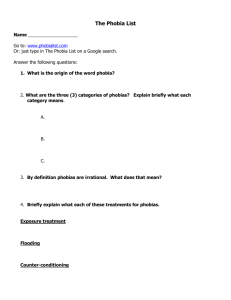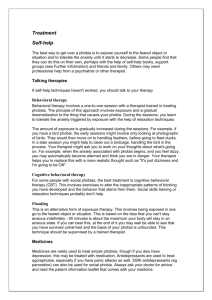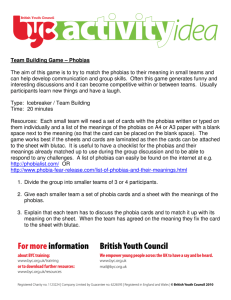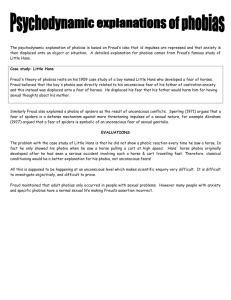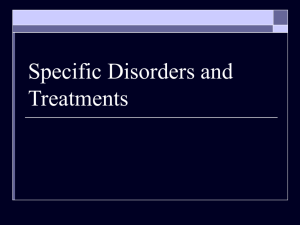File - AICE Psychology
advertisement
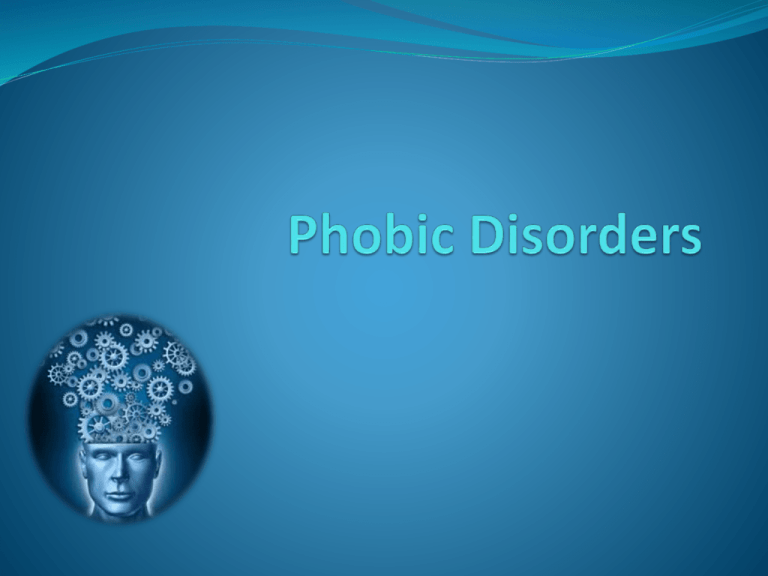
I. AICE Syllabus A. Types of phobias 1. Specific phobias (e.g. blood phobias) 2. Agoraphobia 3. Social Phobias 4. Case studies B. Explanations 1. Behavioral 2. Psychoanalytic 3. Biomedical 4. cognitive C. Treating Phobias 1. Systematic Desensitization 2. Flooding 3. Applied tension 4. CBT II. Types of Phobias A. Phobias in general 1. Considered a type of anxiety disorder that also includes PTSD and OCD as well as Generalized Anxiety Disorder 2. Anxiety = a general felling of dread or apprehensiveness accompanied by various physiological reactions such as increased heart rate, sweating, muscle tension and rapid and shallow breathing. Phobia = a persistent fear of an object or situation in which the sufferer does anything possible to avoid the feared object or situation 4. Differs from ordinary fears in the severity and in the discomfort faced by the sufferer 5. Although we have words for many phobias including koumpounophobia (fear of buttons) most are rare while ones like acrophobia and claustrophobia are more common. 3. B. Specific or simple phobias DSM Criteria 1. 2. 3. 4. 5. 6. 7. Marked fear or anxiety about a specific object or situation. The object always produces immediate fear/anxiety The object is avoided or endured with fear. The fear is out of proportion to the actual danger Typically last 6 months or longer Causes significant distress or impairment Not better explained by some other mental disorders such as agoraphobia C. The DSM classifies 5 subtypes of specific phobias 1. 2. 3. 4. 5. Animal – including spiders, insects and dogs Natural Environment – heights, storms or water Blood-injection or injury – fear of needles, blood or any invasive procedure Situational – airplanes, elevators and enclosed spaces Other – choking, vomiting, clowns or other costumed characters D. Prevalence and Course 1. 12 month prevalence in the US is 7-9% 2. 5% for children and 16% for 13-17 year olds, then back down to 3-5% for older adults 3. Females 2x likely in most but 1:1 in blood phobias 4. Most specific phobias develop in early childhood before age 10 E. Agoraphobia = traditionally the fear of the “agora” or the open marketplace. This term now includes fear of most public places Marked fear of 2 or more of the following 1. a. b. c. d. e. Public transportation Being in open spaces (parking lots or open air markets) Being in closed in spaces (shops, malls or movie theaters) Standing in line or being in a crowd Being outside of the home alone 2. 3. 4. 5. 6. The individual fears or avoids these situations The situations almost always provokes fear or panic The fear or anxiety is out of proportion to the actual danger Causes clinically significant distress Not better explained by some other condition like BDD. Prevalence and Course 7. a. b. c. d. 1.7% of teens and adults have this Dx Only .4% in individuals older than 65 Only in rare cases is this not accompanied by panic disorder Complete remission is rare (only 10% completely recover) F. Social Anxiety (Social Phobia) = First identified in 1960’s DSM 5 Criteria 1. a. b. c. d. e. f. Marked fear or anxiety about one or more social situations where the individual is exposed to the scrutiny of others. Fears being negatively evaluated (awkward) The social situation almost always produces fear/panic Social situation is avoided Out of proportion to actual danger Causes significant distress Prevalence and Course 2. a. b. c. d. In the US about 7% of the pop. in a 12 month period Lower in Europe about 2.3% Men and women roughly equal Generally starts in adolescence G. Famous Case Studies 1. Little Hans – a. b. c. d. e. Case study completed by Freud on a boy with the pseudonym Hans. Lasted 2 years Boy in the phallic stage fascinated with his widdler. Hans develops a fear of horses which Freud explains as an example of the Oedipal Crises. The boy is really afraid of his father but his Ego manifests this as being afraid of horses Review the adv/dis adv of case studies and this study as a whole Little Albert 2. a. b. c. d. Famous case studied by Watson and Rayner Little Albert conditioned to fear white rat Rat is the CS and it is paired with the UCS a loud noise repeated. Each time the UCS is presented the child cries (UCR). Eventually after repeated pairings the child cries at the sight of the Rat (CR) This case was used as evidence of the behavioral perspective of the cause of Phobias as opposed to the case of Little Hans which supported the Psychodynamic Perspective III. Explanation of Phobias A. The Behavioral Model 1. Refer back to the Little Albert Study as an explanation 2. Öst and Hugdahl used the Phobic Origins Questionnaire (POQ) to assess the causes of phobias a. b. Found 3 major pathways = aversive conditioning, modeling and transmission of negative information Studies reveal that aversive conditioning and modeling play a much greater role in the formation of phobias than transmission of negative information c. d. e. Found that 58% of adults attributed their phobia to aversive conditioning Aversive conditioning may be especially common in the onset of claustrophobia (Rachman 1997) Transmission of a phobia through modeling was demonstrated in a study by Cook and Mineka on Rhesus monkeys where monkeys who were previously unafraid of snakes developed the fear after watching videos of other Rhesus monkeys reacting with fear to a toy snake. f. g. Generalizations – like Albert generalizing his fear of the rat to a rabbit can explain why one phobia might generalize to other objects or situations This view point has often been criticized because it is too reductionist. B. Psychoanalytic (Freud) 1. You should be able to recall the Little Hans study as support for this idea 2. Phobias represent defense mechanisms against anxiety that stems from the impulses of the id. 3. This viewpoint has been widely criticized as being unscientific C. Genetic and Biological Causes 1. Genetic and temperamental or personality variables are known to affect the speed and strength of conditioning. a. b. Eysenck 1965 found that temperament may directly impact the formation of phobias Biederman et al 1990 found that children who were excessively timid at age 21 months more than 6 times as likely to develop a phobia than their non-inhibited peers. Furthermore they found that they feared more objects as well. Fyer et al 1995 found a modest genetic link in those that had a 1st degree relative with a Dx of a specific phobia 3. Kendler et al 1992 found a large study of twins higher concordance rate in monozygotic twins than dizygotic twins 4. Öst 1992 found a 60% concordance rate with a 1st degree relative for those with blood phobias 5. Others argue that from an evolutionary perspective we have been bred to be more likely to fear certain objects like snakes over others like flowers 2. 6. Ohman, Dimberg and Öst 1985 and Ohman 1996 found in studies of human subjects that is was easier to condition fear relevant stimuli like pictures of snakes and spiders of fear irrelevant stimuli such as flowers and mushrooms 7. Cook and Mineka 1989 found similar findings using toy snakes and toy rabbits with monkeys as subjects. D. Cognitive Explanations 1. Dinardo et all 1988 found in a group of dog phobics that only 50% could tie that phobia to a traumatic experience with dogs. However in those who reported no dog phobia 50% also had a traumatic experience with a dog but did not develop a phobia. The authors believe that the key difference is that in those who developed the fear they had more negative thoughts about the probability of future traumatic events. 2. Kindt & Brosschot 1997 created a Stroop test using words associated with spiders. The words are written in different colors of ink and the participant is to name the color of the word not name the word itself. It took significantly longer to do this with the spider related words IV. Treating Phobias A. Systematic Desensitization (Wolpe) 1. Works on the same principals as learning theory (Lil Albert) 2. Steps in Systematic Desensitatization a. b. Taught relaxation techniques Next the patients create an anxiety hierarchy i. Seeing a cartoon snake ii. Seeing a tv show on snakes iii. Snake in a cage in same room iv. Within 3 feet of a snake Patients cannot move to the next level of the hierarchy without first learning to relax at the previous level 4. Support for Systematic Desensitization 3. a) b) Capafons, Sosa, & Avero 1998 found that in 20 patients with a fear of flying the use of sys. desens. became much less fearful of flying Zettle in 2003 used in people who fear math (yes math)! Anxiety for math decreased significantly after undergoing sys desensitization even without an improvement in math ability. B. Flooding = Instead of the gentle approach of Systematic desensensitization the therapist “floods” the client with the feared stimuli. Supported by Öst in 1988 1. a. Good for a wide variety of specific phobias b. Ideal for patients with 1 fear only and motivated to change c. 1 session treatment using in vivo exposure d. Mean decrease in phobic responses of 78% e. At follow-up most reported complete recovery and 90% reported significant clinical improvement C. Applied Tension 1. Applied muscle tension is a technique developed by Öst in the 1980’s. Designed to help people with blood and injury phobias. Works by repeated contracting muscles to help decrease the fainting response common with these types of phobias 2. Ditto et al 2003 tested the effectiveness of this technique with 605 blood donors. The technique produced significantly less blood phobia symptoms and more full quotas of blood donations 3. Holly, Balegh & Ditto 2011 also supported the use of applied tension in a group of 70 participants. Showed significant reduction in fainting syptoms. D. CBT- Öst and Westling 1995 did a study comparing applied tension to CBT plus applied tension. The group getting both had a 74% reduction in panic attacks and 89% reduction at follow-up
